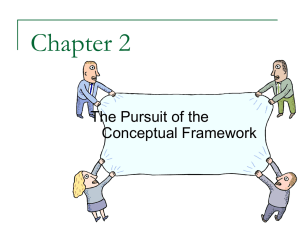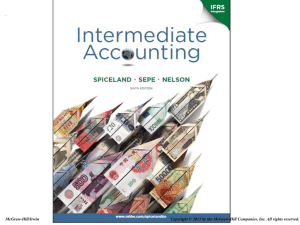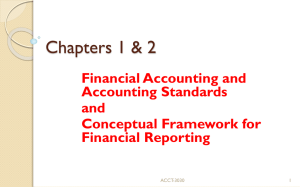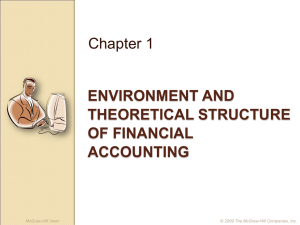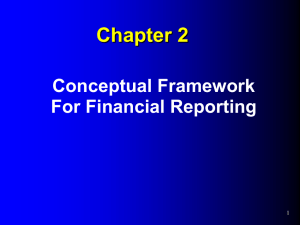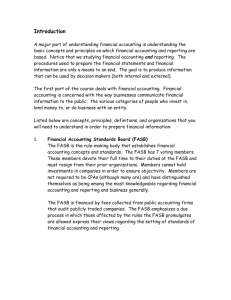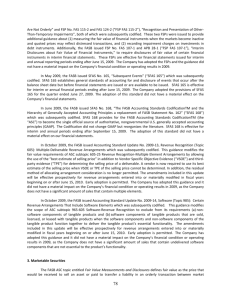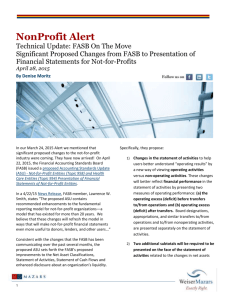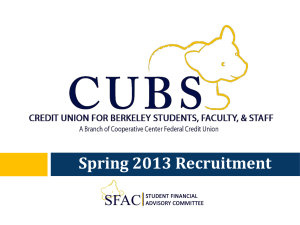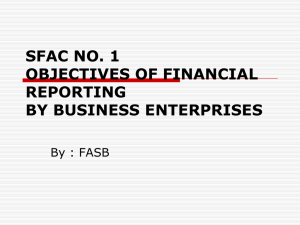Conceptual Framework and Standard Setting
advertisement
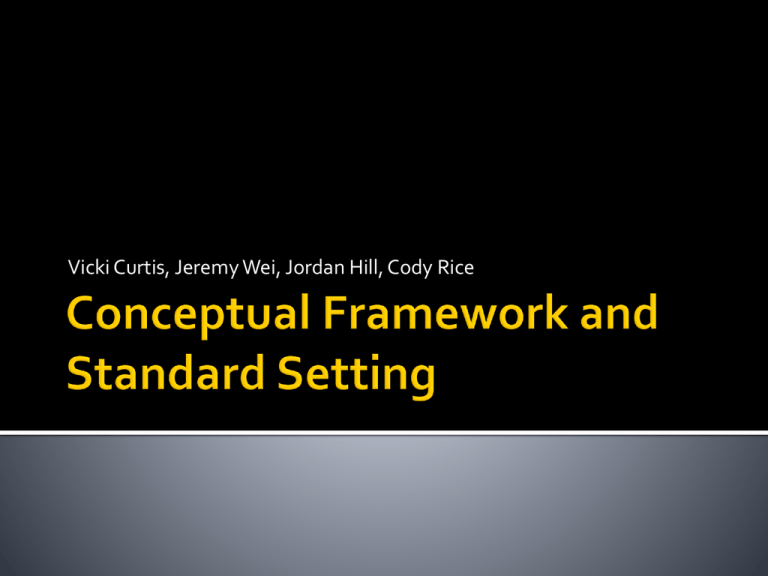
Vicki Curtis, Jeremy Wei, Jordan Hill, Cody Rice Introductions “Does the FASB’s Conceptual Framework Solve Real Accounting Issues?” Purpose Benefits, Successes Opposition, Failures “Changing the Concepts to Justify the Standards” “Relevance, Reliability, and the Earnings Quality Debate” Relevance: “Accounting Loses Focus on Reality” Reliability: “Accounting Remains Patient” Group Activity Created the conceptual framework (1985) Considerable resources consumed Usefulness still in question Will shortly review the benefits, successes, opposition, and failures Explained by the FASB as follows: “The existing Concepts Statements are intended to serve the public interest by setting objectives, qualitative characteristics, and other concepts that guide selection of economic events to be recognized and measured for financial reporting and their display in financial statements or related means of communicating information to those who are interested.” A foundation that provides guidance for standard setting Synergies between interrelated standards Streamlines the process to improve the response time No room for political pressure Normative describing the goals and underlying concepts of financial reporting SFAC 2: - Qualitative characteristics to guide the FASB in making decisions SFAC 1: - Provides the overall objectives of Financial Reporting - Explicit cost/benefit constraint when developing standards SFAC 1 & 2: - Raised the importance of users of statements - Critical to continuation of selfregulation SFAC 6: Lists and Defines elements of financial statements - Time saving - Results in consistency - Most-referenced Many scholars/academics feel there is no reason to implement a framework to an 80year old profession Some practitioners desire to keep the status quo Mainly small-medium sized firms Hickok argues that it is not up to accountants to be forward thinking, merely historians The author disagrees An opponent (Beresford) does believe that there is some usefulness to the framework: Standardizes the method used to debate accounting issues Allows more focus on the issues, although not solving them Listing out a foundation would simply describe the current situation SFAC 5: Revenue Recognition and Measurement Many believe that the FASB failed on this concept Did not solve the issue; simply described present practice Does not address what choice of accounting treatment should SFAC 5: Revenue Recognition and Measurement FASB counsel cannot reach an agreement More rulesbased Exceptions to case-specific issues were allowed; contradicting the framework’s guidelines SFAS 96: Accounting For Income Taxes No recognition or measurement criteria (ie SFAS 6) Recognition of deferred taxes hinges on when the deferred amount is recognized as an asset or liability and how to measure it (i.e. to discounted or nondiscounted) SFAS 52: Foreign Currency Translation Arguers on both sides of the debate were able to reference SFAC 2 as their reasoning, which undermines the whole concept of the framework Discusses convergence of IASB and FASB Argues it is simply a shift towards fair valuation and away from stewardship, reliability, and earnings How investors analyze financial statements Chartists and Indexers Financial statements are inputs to valuation not the valuation itself Earnings vs. financial position Heavy emphasis on historical costs while neglecting the intangible aspects Brand equity – Coke $72.5B brand value R&D – Microsoft $3.8B R&D expense Human Capital – Citigroup its core is its people Stuck in a traditional way of operating (firms invest, accountants expense) which loses sight of the potential for the intangible 160% 140% 120% 100% 80% 60% 40% 20% 0% Coke Nike Hertz Adidas Heavy emphasis on historical costs while neglecting the intangible aspects Brand equity – Coke $72.5B brand value R&D – Microsoft $3.8B R&D expense Human Capital – Citigroup its core is its people Stuck in a traditional way of operating (firms invest, accountants expense) which loses sight of the potential for the intangible “Future economic benefits” Definition of asset fits the value of brands, R&D, and human capital Frozen preference for reliability over relevancy Overcome past difficulty of valuing intangibles (Boston Consulting & KPMG) Ongoing separation of the market value of a company vs. the book value people believe that this is becoming an issue Article tries to answer the question as to when intangible assets (e.g. R+D, Brand Value, etc...) should be accounted for as assets Firstly, as per FASB - financial accounting is NOT designed to measure the value of a business enterprise Secondly, irrational to use the stock market as a basis of valuation, as many times the stock market is based on non-sensical emotion When should these intangible assets be recorded in the financial statements? Thus, we will never record these intangible assets on the balance sheet and only the resulting “economic benefits” since: Coke isn’t in the “business” of building brand equity Microsoft isn’t in the “business” of building R+D infrastructure McDonald's isn't in the “business” of enhancing human capital We record these benefits when: we reliably confirm that the asset truly exists (i.e. with each sale of a Big Mac) once accounting has proof (beyond a reasonable doubt) of the existence of these assets Information is found everywhere, however, reliable information is a rare commodity, and it is worth waiting for 10 minutes for discussion 5 minutes to debate The future of financial accounting rests with you!!!
